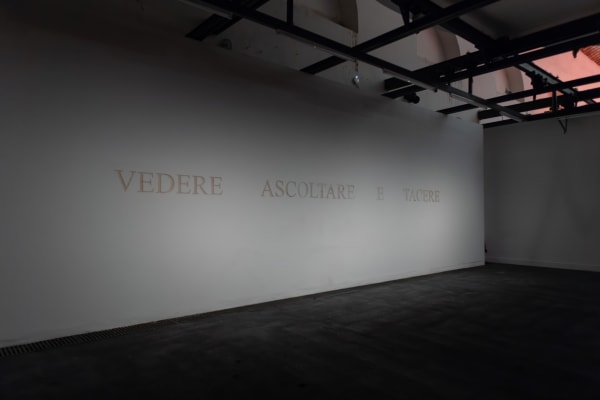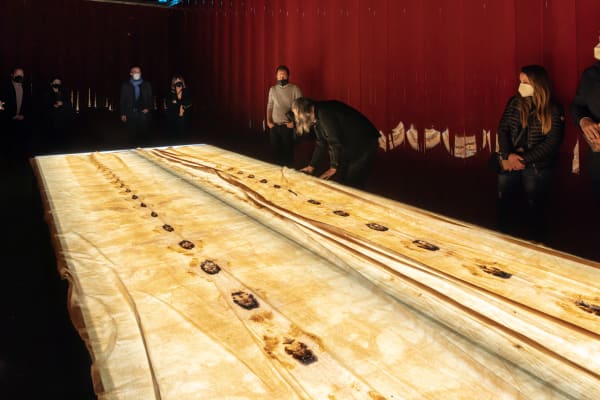From this standpoint, the Mexican artist brings into the context of art the space of death, a metaphor par excellence of the border, of a limit that is paradoxically reached only at the moment when we no longer exist, and thus are unable to recount it. An attempt to counter inurement and powerlessness in the face of daily tragedies such as gender violence or the exploitation of illegal immigration, caused by the inaction of governments and by melodramatic and sensationalistic exploitation on the part of the media.
The Periferia dell’agonia presented at the Mattatoio di Roma is configured through an environmental installation occupying the whole of Pavilion 9B and through a series of actions that gradually unfold without any regular rhythm or pace for the entire duration of the exhibition, permeating both the interior of the exhibition space and, more importantly, the urban space of the city.
The interior of the pavilion is occupied by a perimeter of red plastic industrial curtains conceived as a body pierced, injured, knifed, penetrated and penetratable, and at the same time as a limbo in which everything is pending, filled with question marks without any concrete feedback and devoid of all certainty or reassurance as to what is going to happen or what might happen. Within this perimeter, a large backlit table hosts a cloth 23 mt long used in the past to cover the corpses of murder victims, mapping out a synaesthetic pathway on which the audience is urged to walk peripherally around others’ agony. This cloth becomes a form of cenotaph in which the violence suffered that it documents casts its shadow over us, highlighting the extent to which the dynamics, problems and excuses used to impart legitimacy to those acts of violence are in fact far closer than we think. A mood of suspension that points on the one hand to the structure of the project in which unpredictability prevails, and on the other, to the despair and the disappearance of thousands of people on the border between Mexico and the United States, seen as a paradigmatic example of the countless visible and invisible borders that exist throughout the world.
This environment is inhabited at irregular intervals by actions and by their documentation. A mapping of the places in which murders have taken place in the city of Rome is activated by participants marking the terrain with water and soaking up the materials of each scene with a sponge, gathering what traces remain and turning us all into witnesses of what has taken place. The cloth, the epicentre of the exhibition, is raised to cast its shadow onto the floor. These are only some of the actions which in most cases are performed spontaneously, like the urgency of a given moment, of a vision, of a concrete event, and which, together with others, reassemble the fragments of a generic image crumbled by an alarming aggressiveness that is frequently anaesthetised, concealed or ignored. Without directly using base matter, Margolles reconstructs the absent corpse and the violence visited on it through a string of actions recalling those losses without exploiting them and without publicising them, causing the community to participate and, above all, increasing its awareness.
In this way. Teresa Margolles becomes a witness to pain and violence in order to preserve the memory of those who are no longer with us and to hand down their story, to acknowledge their identity and to help avoid the most important enemies whom the victims and their families generally come up against: the absence of information regarding deaths, the impunity of those responsible for those deaths, the authorities’ slapdash investigations, the fear that prompts oblivion, the destruction of the domestic balance and the inevitable transformation of the shape of a city. Yet her works become aesthetically reassuring and pleasing allegories: lacerated bodies or corpses are never shown. That is when the trap is sprung for visitors. Only the power of their imagination can lend a momentary presence to the inconceivable. Unaware, they draw close, they observe, they read, they are acquainted with the drama, the tragedy, and that is when they are prompted to elaborate, to reconstruct and to order through a process of direct emotional, cognitive and sensory involvement. Only at that moment does the visitor become at once witness and spectator, victim and murderer, innocent and guilty, extraneous and an accomplice, and only at that moment must he or she take responsibility for deciding, for not hesitating, for not turning the other way, for not remaining indifferent.
Curator: Angel Moya Garcia









